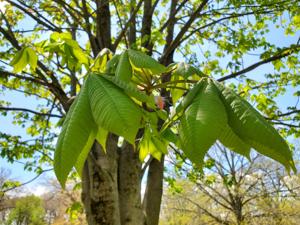Most of our native trees have a home range that extends well beyond Illinois, and Ohio buckeye (Aesculus glabra), as its common name implies, is no different. The center of its home range lies across Ohio, Indiana, Illinois and Missouri, but it has scatter distribution in many other neighboring states, as far north as Wisconsin and as far south as Texas. So, its safe to say this tree species is adaptable to a wide range of growing conditions.
In nature, Ohio buckeye often occurs near bottomland areas, and that’s where I most commonly see it around central Illinois. It usually thrives in rich, protected woodland sites, often referred to by foresters as “mesic.” These mesic sites are usually north- or east-facing and are characterized by deeper, higher-quality soils that fuel greater tree growth than more south-facing or exposed sites (known as xeric).

However, buckeye is also known to occur on rocky slopes and bluffs in other parts of the state that don’t boast the high productivity and deep soils of more mesic sites. One common thread among the sites it occupies in nature is that most are somewhat protected from prevailing winds, despite the varying soil conditions it may tolerate. As an urban tree, buckeye is quite adaptable to a variety of urban soil conditions and does well on most sites.
Just like its preferences in nature, it will not do well in a location overly exposed to wind. I see quite a few buckeyes planted in rural areas that are very open and windy. Although they survive, their leaves can become scalded from the exposure, with dead margins and an unattractive look.
So, it pays to think about the planting location ahead of time and avoid windy sites. Buckeye ranks up near the top of my “favorite natives” list for both its ornamental attributes and ecological benefits. As a landscape tree, it has interesting palmately compound leaves, which are quite unique among both native and non-native trees.
They emerge very early in the season, providing a nice bit of green in the spring before other trees leaf out. Its bark and stems are a much lighter color than most other trees and remain fairly smooth on younger limbs, offering an interesting bark character. Perhaps its greatest ornamental attribute is its beautiful flowers.
The large terminal clusters of flowers can reach up to 12 inches, emerging after full leaf development. The yellowish flowers really stand out against its dark green leaves, creating a flowering display second to none. Large, showy flowers are common among trees that are insect pollinated, and Ohio buckeye is pollinated by a variety of bees and hummingbirds.
This early source of nectar and pollen is great support for early-emerging native bees. The tree also supports 32 species of lepidopteran caterpillars, which use its canopy for food and shelter. Mammals may use buckeye for shelter but are not consumers of this plant.
Its leaves, twigs and famous nuts are all toxic to mammalian life. While this may be a downside when considering Ohio buckeye’s ecological benefits, its actually helpful when planting these trees in areas with deer or rabbit pressure. Buckeye is naturally resistant to browse due to its toxicity.
This year, Ohio buckeye had the distinct honor of being the species planted on the University of Illinois campus in honor of Arbor Day, which occurred April 25. Each year, the university celebrates the community benefits of trees by planting a tree species specially selected by campus arborists. I was thrilled to be a part of yesterday’s Arbor Day celebration highlighting our campus’ commitment to its trees.
Ohio buckeye was a great selection to add to our large campus tree population, which number over 18,000. If you are interested in planting a tree for Arbor Day, its never too late. Consider adding one of our native species to your property to help boost the diversity of our urban forests.
For more information on tree planting, please visit go.illinois.edu/gardenscoop or download Illinois Extension’s Tree and Shrub Planting Guide at go.
illinois.edu/treeplantingguide ..
Politics

In the Garden | Resilient bunch

Most of our native trees have a home range that extends well beyond Illinois, and Ohio buckeye (Aesculus glabra), as its common name implies, is no different. The center of its home range lies across Ohio, Indiana, Illinois and Missouri,...















